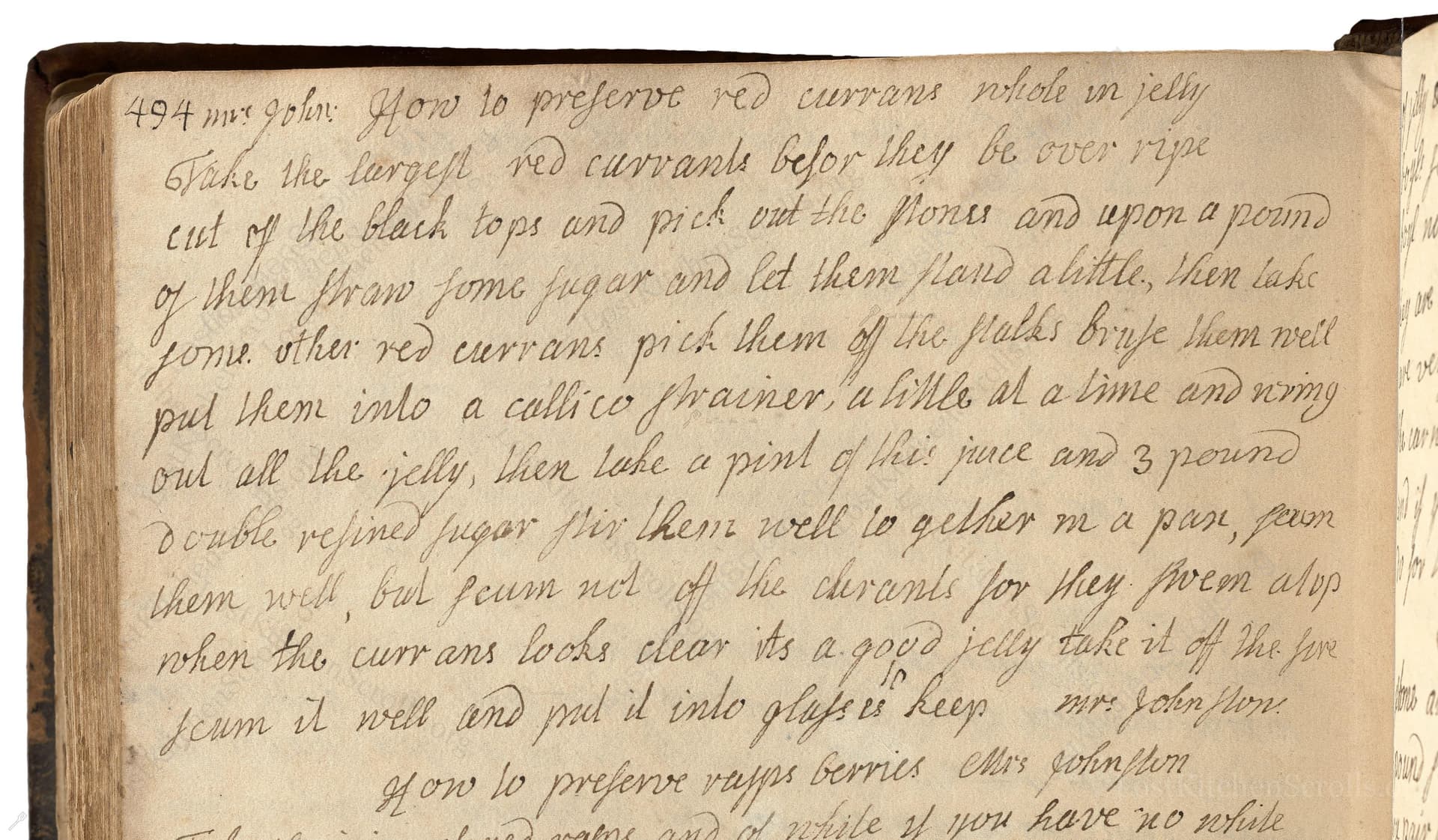How To Preserve Red Currants Whole In Jelly
From the treasured pages of Cookbook
Unknown Author

How To Preserve Red Currants Whole In Jelly
"Take the largest red currants befor they be over ripe cut of the black tops and pick out the stones and upon a pound of them straw some sugar and let them stand a little, then take some other red currants pick them of the stalks bruise them well put them into a callico strainer a little at a time and wring out all the jelly, then take a pint of this juice and 3 pound double refined sugar stir them well to gether in a pan, scum them well, but scum not of the currants for they swim atop when the currants looks clear its a good jelly take it of the fire scum it well and put it into glasses keep mrs johnson."
Note on the Original Text
The recipe is written as a narrative, much like spoken instruction, with little punctuation or measurement standardization. Spelling reflects Early Modern English, so 'scum' means ‘skim,’ and 'be for' is equivalent to 'before.' No exact times or temperatures are given—the cook was expected to judge readiness by sight and texture, watching for when 'the currants look clear.' This style assumes a foundational knowledge of jelly making, typical of skilled domestic cooks of the time.

Title
Cookbook (1706)
You can also click the book image above to peruse the original tome
Writer
Unknown
Era
1706
Publisher
Unknown
Background
Step back to the early 18th century with this charming culinary collection, brimming with period recipes that tantalize the tastebuds and offer a delicious glimpse into historic kitchens.
Kindly made available by
Folger Shakespeare Library
This recipe is drawn from an English manuscript dated approximately 1706—a period rich with home preservation techniques. Sugar was precious, so recipes for jams and jellies were reserved for special fruits like currants. Households, particularly among the gentry, prized the ability to capture the season’s bounty through preserving. The attribution to 'mrs johnson' likely refers to either a household’s cook or a family member renowned for her culinary prowess, whose recipes circulated and were trusted by contemporaries.

The original cook would have needed a sharp knife for trimming currants, a sturdy mortar and pestle or the back of a spoon for bruising, and a calico (cotton) strainer for extracting juice—much like a fine, reusable cheesecloth today. The cooking itself happened in large cast-iron pans or copper preserving pans, set over an open fire or on a range. All finished preserves were stored in small glass jars or glasses, often sealed with paper, leather, or wax.
Prep Time
25 mins
Cook Time
20 mins
Servings
16
We've done our best to adapt this historical recipe for modern kitchens, but some details may still need refinement. We warmly welcome feedback from fellow cooks and culinary historians — your insights support the entire community!
Ingredients
- 1 lb large red currants (whole, just-ripe; substitute: frozen red currants if fresh unavailable)
- 1 lb red currants (crushed for juice)
- 3 lb double refined sugar (use white granulated sugar for modern equivalent)
- 2 oz white sugar for macerating
- Muslin or cheesecloth for straining
Instructions
- Begin by selecting the largest, just-ripe red currants—around 1 lb.
- With a small knife, carefully trim off any remaining stems or 'black tops'.
- Remove seeds if desired, though modern currants tend to be nearly seedless.
- Layer sugar (about 2 oz) over the currants and let them rest for 15–20 minutes to draw out their juices.
- Meanwhile, take another 1 lb of currants, remove from stems, and crush them well, either with a fork or potato masher.
- Place the crushed fruit into a fine muslin cloth or cheesecloth, then twist and wring out as much juice as possible into a bowl.
- For the jelly, mix 1 pint of this juice with 3 lb of white, granulated sugar in a heavy-bottomed saucepan.
- Stir constantly over medium heat until the sugar dissolves fully (do not boil until dissolved).
- Skim off any foam as it rises.
- Once the mixture thickens and becomes clear, gently add the reserved whole currants.
- Cook just until the whole currants are translucent and floating.
- Remove from heat, skim again, and ladle into sterilized glass jars or heat-proof glasses.
- Let cool and set.
- Store in a cool place.
Estimated Calories
90 per serving
Cooking Estimates
Prep time includes washing, trimming, macerating, and juicing the currants. Cooking time is for dissolving the sugar, thickening the jelly, and gently cooking the whole currants. This recipe typically yields about 6 standard (240ml) jars, with each serving about a tablespoon (roughly 16 servings per batch). Each serving has approximately 90 calories because of the high sugar content.
As noted above, we have made our best effort to translate and adapt this historical recipe for modern kitchens, taking into account ingredients nowadays, cooking techniques, measurements, and so on. However, historical recipes often contain assumptions that require interpretation.
We'd love for anyone to help improve these adaptations. Community contributions are highly welcome. If you have suggestions, corrections, or cooking tips based on your experience with this recipe, please share them below.
Join the Discussion
Rate This Recipe
Dietary Preference
Main Ingredients
Culinary Technique

Den Bockfisch In Einer Fleisch Suppen Zu Kochen
This recipe hails from a German manuscript cookbook compiled in 1696, a time whe...

Die Grieß Nudlen Zumachen
This recipe comes from a rather mysterious manuscript cookbook, penned anonymous...

Ein Boudain
This recipe comes from an anonymous German-language manuscript cookbook from 169...

Ein Gesaltzen Citroni
This recipe, dating from 1696, comes from an extensive anonymous German cookbook...
Browse our complete collection of time-honored recipes



